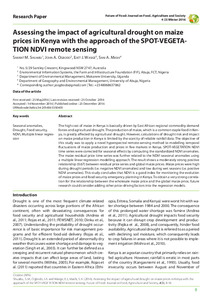| dc.date.accessioned | 2017-01-03T16:27:47Z | |
| dc.date.available | 2017-01-03T16:27:47Z | |
| dc.date.issued | 2016-12-23 | |
| dc.identifier.issn | 2197-411X | |
| dc.identifier.uri | urn:nbn:de:hebis:34-2016061350401 | |
| dc.identifier.uri | http://hdl.handle.net/123456789/2016061350401 | |
| dc.language.iso | eng | |
| dc.publisher | Department of Organic Food Quality and Food Culture at the University of Kassel, Germany and Federation of German Scientists (VDW) | eng |
| dc.rights | Urheberrechtlich geschützt | |
| dc.rights.uri | https://rightsstatements.org/page/InC/1.0/ | |
| dc.subject | Seasonal anomalies | eng |
| dc.subject | Drought | eng |
| dc.subject | Food security | eng |
| dc.subject | NDVI | eng |
| dc.subject | Multiple linear regression | eng |
| dc.subject.ddc | 630 | |
| dc.title | Assessing the impact of agricultural drought on maize prices in Kenya with the approach of the SPOT-VEGETATION NDVI remote sensing | eng |
| dc.type | Aufsatz | |
| dcterms.abstract | The high cost of maize in Kenya is basically driven by East African regional commodity demand forces and agricultural drought. The production of maize, which is a common staple food in Kenya, is greatly affected by agricultural drought. However, calculations of drought risk and impact on maize production in Kenya is limited by the scarcity of reliable rainfall data. The objective of this study was to apply a novel hyperspectral remote sensing method to modelling temporal fluctuations of maize production and prices in five markets in Kenya. SPOT-VEGETATION NDVI time series were corrected for seasonal effects by computing the standardized NDVI anomalies. The maize residual price time series was further related to the NDVI seasonal anomalies using a multiple linear regression modelling approach. The result shows a moderately strong positive relationship (0.67) between residual price series and global maize prices. Maize prices were high during drought periods (i.e. negative NDVI anomalies) and low during wet seasons (i.e. positive NDVI anomalies). This study concludes that NDVI is a good index for monitoring the evolution of maize prices and food security emergency planning in Kenya. To obtain a very strong correlation for the relationship between the wholesale maize price and the global maize price, future research could consider adding other price-driving factors into the regression models. | eng |
| dcterms.accessRights | open access | |
| dcterms.bibliographicCitation | In: Future of Food: Journal on Food, Agriculture and Society. Witzenhausen : University of Kassel, Department of Organic Food Quality and Food Culture. - Vol. 4, No. 3 (2016), S. 8 - 18 | |
| dcterms.creator | Shuaibu, Sakirat M. | |
| dcterms.creator | Ogbodo, John A. | |
| dcterms.creator | Wasige, Ejiet J. | |
| dcterms.creator | Mashi, Sani A. | |

